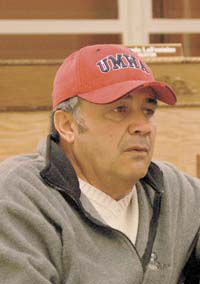| Councilmember David Maggio listens to the discussion about securing CIB money to fund a proposed East Carbon-Sunnyside public safety building project. |
East Carbon and Sunnyside city officials met Jan. 30 to discuss the furtherance of an interlocal agreement that has been in the works for nearly three months.
The agreement would outline stipulations to be met by both cities in order to maintain a public safety building that would collectively house the municipalities’ fire departments and the Sunnyside ambulance service.
The contract was discussed with members of the Utah Permanent Community Impact board via conference call on Jan. 26.
The work meeting served as a way for the elected officials of the two cities to iron out the concerns expressed during the conference call with the CIB.
“I have heard rumor that, if we can’t have this agreement completed before the April CIB funding meeting, we will lose our chance. This is not true. The board assured us that as long as we are moving forward we will continue to be eligible,” said East Carbon Mayor Orlando LaFontaine.
According to Joyce Caviness, East Carbon City councilmember, the CIB wanted to see a more detailed agreement before the board could commit to funding.
“They want an itemized portion in the contract that would specify who would pay what when it came to utilities and maintenance,” reported Caviness.
With that in mind, the group worked through a draft of the agreement line by line.
The first issue brought up for discussion was the executive board that would govern the safety building.
According to the draft agreement, the joint board would consist of five members. The panel would consist of the East Carbon and Sunnyside mayors, one council person from each city and one citizen of the county or one resident from each town who is mutually agreed upon by the other four members of the board.
East Carbon councilmember David Maggio took exception to the composition of the panel, stating that selecting a citizen from each city would result in a six member board that would not be able to break a tie in voting situations.
When the group moved in the direction of choosing to have someone from the county fill the position instead of two local residents, Sunnyside city councilmember Doug Parsons objected.
“I believe we have to involve our own citizens for this to work effectively, we cannot leave them out,” stated Parsons.
The group agreed and approved changing the contract to specify that the board would be comprised of seven members, including one resident from each city and an independent citizen from within Carbon County.
Section 3.4 of the agreement stipulates that the joint board shall be responsible for approval and oversight of finance and budget matters.
According to Sunnyside Mayor Bruce Andrews, it would be inappropriate for the public safety board to have any power over the cities, budget and finances.
The consortium agreed and changed the draft to state that the board would make recommendations to the city council for approval.
Section nine of the draft states that both cities agree to share the cost of operation, maintenance and insurance of the public safety building equally, with the expectation of the utilities for the ambulance portion of the building which will be operated on a separate meter and the responsibility of Sunnyside city.
According to the group this is where the CIB wanted to see more specifics. The group agreed to have Sunnyside be the lead city in this instance, meaning that they will receive and pay all utility bills. Sunnyside will then bill East Carbon for their portion of the utilities. The cities further stipulated that they will alternate years concerning the snow removal and summer maintenance for the property. The wording in the document was also changed to reflect that “no city will pay more than 50 percent of any cost for maintenance or utilities.”
The draft of the contract states that the term of the agreement be for 50 years, pursuant to Utah Code 11-13-204, unless renewed as permitted by law or until earlier dissolved. Either party may terminate this agreement with or without cause, by giving the other party 90 days prior notice of its intent to terminate. Upon termination of this agreement any property, assets or funds shall be sold according to law and distributed equally between the parties. The parties shall each have first option to purchase the other party’s interest in the property or assets from the other at the value determined by an independent appraiser.
The group felt that lawyers from each party needed to go over this section of the document to insure its legality and to define the status of the property if the remaining city was fiscally unable to buy out the vacating city’s portion.
Upon approval from legal council the cities plan to meet again to discuss changes in the design of the building as soon as possible.

